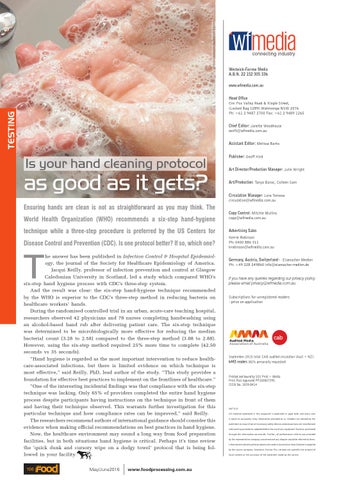©stock.adobe.com/au/Vladimir Voronin
Westwick-Farrow Media A.B.N. 22 152 305 336 www.wfmedia.com.au
TESTING
Head Office Cnr. Fox Valley Road & Kiogle Street, (Locked Bag 1289) Wahroonga NSW 2076 Ph: +61 2 9487 2700 Fax: +61 2 9489 1265 Chief Editor: Janette Woodhouse wnift@wfmedia.com.au Assistant Editor: Melissa Barks
Is your hand cleaning protocol
as good as it gets? Ensuring hands are clean is not as straightforward as you may think. The World Health Organization (WHO) recommends a six-step hand-hygiene technique while a three-step procedure is preferred by the US Centers for Disease Control and Prevention (CDC). Is one protocol better? If so, which one?
T
he answer has been published in Infection Control & Hospital Epidemiology, the journal of the Society for Healthcare Epidemiology of America. Jacqui Reilly, professor of infection prevention and control at Glasgow Caledonian University in Scotland, led a study which compared WHO’s six-step hand hygiene process with CDC’s three-step system. And the result was clear: the six-step hand-hygiene technique recommended by the WHO is superior to the CDC’s three-step method in reducing bacteria on healthcare workers’ hands. During the randomised controlled trial in an urban, acute-care teaching hospital, researchers observed 42 physicians and 78 nurses completing handwashing using an alcohol-based hand rub after delivering patient care. The six-step technique was determined to be microbiologically more effective for reducing the median bacterial count (3.28 to 2.58) compared to the three-step method (3.08 to 2.88). However, using the six-step method required 25% more time to complete (42.50 seconds vs 35 seconds). “Hand hygiene is regarded as the most important intervention to reduce healthcare-associated infections, but there is limited evidence on which technique is most effective,” said Reilly, PhD, lead author of the study. “This study provides a foundation for effective best practices to implement on the frontlines of healthcare.” “One of the interesting incidental findings was that compliance with the six-step technique was lacking. Only 65% of providers completed the entire hand hygiene process despite participants having instructions on the technique in front of them and having their technique observed. This warrants further investigation for this particular technique and how compliance rates can be improved,” said Reilly. The researchers recommend authors of international guidance should consider this evidence when making official recommendations on best practices in hand hygiene. Now, the healthcare environment may sound a long way from food preparation facilities, but in both situations hand hygiene is critical. Perhaps it’s time review the ‘quick dunk and cursory wipe on a dodgy towel’ protocol that is being followed in your facility. 106
May/June2016
www.foodprocessing.com.au
Publisher: Geoff Hird Art Director/Production Manager: Julie Wright Art/Production: Tanya Barac, Colleen Sam Circulation Manager: Lora Tomova circulation@wfmedia.com.au Copy Control: Mitchie Mullins copy@wfmedia.com.au Advertising Sales Kerrie Robinson Ph: 0400 886 311 krobinson@wfmedia.com.au Germany, Austria, Switzerland - Eisenacher Medien Ph: +49 228 249860 info@eisenacher-medien.de If you have any queries regarding our privacy policy please email privacy@wfmedia.com.au
Subscriptions for unregistered readers - price on application
September 2015 total CAB audited circulation (Aust + NZ): 6443 readers (82% personally requested)
Printed and bound by SOS Print + Media Print Post Approved PP100007395 ISSN No. 1039-8414
NOTICE: All material published in this magazine is published in good faith and every care is taken to accurately relay information provided to us. Readers are advised by the publishers to ensure that all necessary safety devices and precautions are installed and safe working procedures adopted before the use of any equipment found or purchased through the information we provide. Further, all performance criteria was provided by the representative company concerned and any dispute should be referred to them. Information indicating that products are made in Australia or New Zealand is supplied by the source company. Westwick-Farrow Pty Ltd does not quantify the amount of local content or the accuracy of the statement made by the source.
